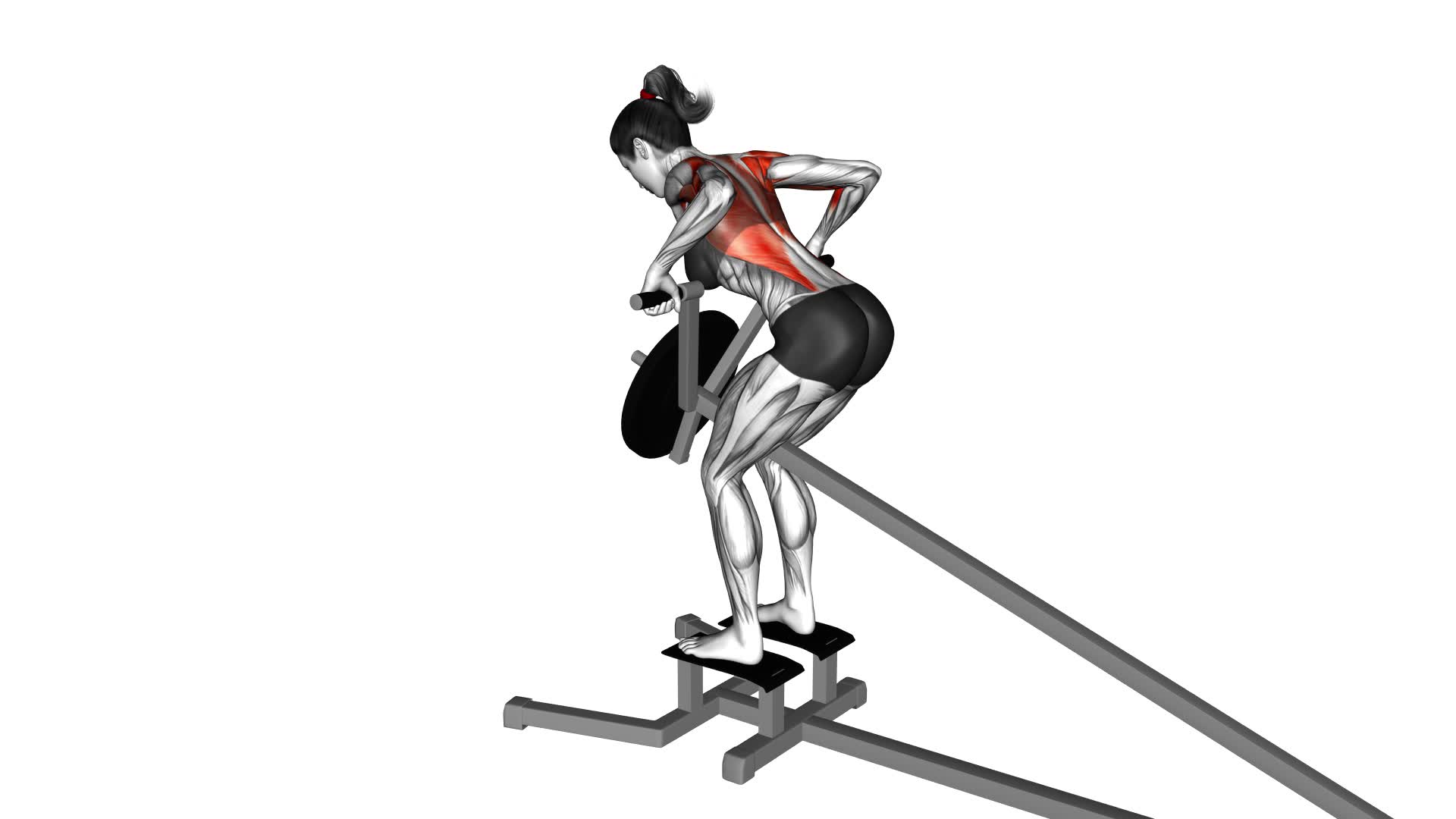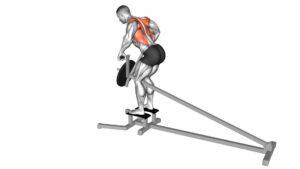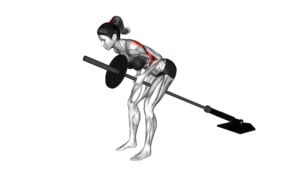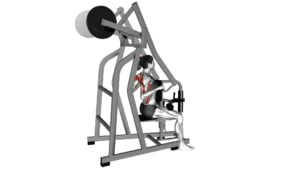Lever T-Bar Row (Plate Loaded) (Female) – Video Exercise Guide & Tips

Are you looking for a challenging and effective back exercise? Look no further than the Lever T-Bar Row.
Watch This Exercise Video
This plate-loaded exercise targets your back muscles and can be modified to suit your fitness level.
In this video exercise guide, we'll walk you through the proper form and technique, providing valuable tips along the way.
Get ready to strengthen and sculpt your back with this powerful exercise. Let's get started!
Key Takeaways
- The lever T-bar row machine is a plate-loaded equipment that provides stable and controlled movement for the exercise.
- Alternatives to the lever T-bar row machine include bent-over rows using dumbbells or barbells, seated cable rows, and bodyweight exercises like inverted rows.
- Proper form and technique for the lever T-bar row include using a firm grip, positioning feet shoulder-width apart, keeping the back straight and engaging core muscles, pulling the handle towards the chest, and controlling the weight during the movement.
- The lever T-bar row primarily targets the latissimus dorsi (lats), but also engages the rhomboids, trapezius, and rear deltoids. It helps improve posture, reduces the risk of injury, and strengthens core muscles for stability and balance.
Equipment Needed
To perform the Lever T-Bar Row (Plate Loaded) exercise, you'll need the following equipment. Firstly, you'll need a T-bar row machine, which is specifically designed for this exercise. The T-bar row machine consists of a lever arm with a handle at one end and a weight plate loaded at the other end. It allows you to perform a controlled rowing motion while targeting your back muscles.
The benefits and advantages of using a T-bar row machine are numerous. Firstly, it provides a more stable and controlled movement compared to other rowing exercises. This helps to minimize the risk of injury and allows you to focus on targeting your back muscles effectively. Additionally, the machine allows for progressive overload by easily adjusting the weight plates, allowing you to increase the resistance as you get stronger.
If you don't have access to a T-bar row machine, there are alternative exercises you can do to target your back muscles. Some alternatives include bent-over rows using dumbbells or barbells, seated cable rows, or even bodyweight exercises such as inverted rows. These exercises can provide similar benefits and advantages, although they may require different equipment or modifications in technique.
Proper Form and Technique
Use a firm grip on the handle and position yourself with your feet shoulder-width apart. This will provide stability and help you maintain proper form during the Lever T-Bar Row exercise. Here are some important tips to ensure you perform the exercise correctly:
- Keep your back straight and engage your core muscles throughout the movement. This will help prevent any excessive strain on your lower back and maintain proper alignment.
- Pull the handle towards your chest, squeezing your shoulder blades together. Focus on using your back muscles rather than relying on your arms to do the work.
- Control the weight as you lower it back down, maintaining a slow and controlled movement.
- Avoid using excessive momentum or swinging your body during the exercise. This can compromise your form and reduce the effectiveness of the workout.
Following these guidelines will help you avoid common mistakes and maximize the benefits and advantages of the Lever T-Bar Row exercise.
Muscles Targeted
Target your back muscles effectively with the Lever T-Bar Row exercise, promoting strength and stability. This exercise primarily targets the latissimus dorsi, which are the large muscles in your back responsible for movements like pulling and rowing. In addition to the lats, the Lever T-Bar Row also engages the rhomboids, trapezius, and rear deltoids. These muscles work together to stabilize your shoulder blades and upper back, improving posture and reducing the risk of injury.
Performing the Lever T-Bar Row correctly can provide numerous benefits. It helps to build a strong and defined back, increasing overall upper body strength. By strengthening the muscles in your upper back, you can improve your posture and reduce the risk of developing back pain. This exercise also engages the core muscles, providing an added benefit of improving stability and balance.
However, it's essential to avoid common mistakes when performing the Lever T-Bar Row. One common mistake is using too much weight, which can compromise your form and increase the risk of injury. It's crucial to start with a weight that allows you to maintain proper form throughout the exercise. Another mistake is using momentum to lift the weight, which reduces the effectiveness of the exercise. Focus on controlling the movement and engaging the targeted muscles throughout the entire range of motion.
Incorporating the Lever T-Bar Row into your workout routine can help you achieve a strong and well-defined back, improve posture, and enhance overall upper body strength. Remember to start with a weight that challenges you without compromising your form and focus on maintaining control throughout the exercise.
Variations and Modifications
When performing the Lever T-Bar Row exercise, you can enhance its effectiveness and target different muscles by incorporating variations and modifications. Here are some progression options and common mistakes to keep in mind:
- Progression Options:
- Increase the weight: As you get stronger, gradually add more weight to challenge your muscles.
- Change grip width: Altering the width of your grip can shift the emphasis on different muscles, such as focusing more on the lats or upper back.
- Single-arm rows: Performing the exercise with one arm at a time can help improve balance and stability while targeting each side of your back separately.
- Superset with other exercises: Incorporate the Lever T-Bar Row into supersets with exercises like pull-ups or dumbbell rows to create a more intense workout.
- Common Mistakes:
- Using momentum: Avoid using momentum to lift the weight. Instead, focus on controlled movements to engage the targeted muscles effectively.
- Rounded back: Maintain a neutral spine throughout the exercise and avoid rounding your back, as this can lead to strain or injury.
- Incorrect grip: Ensure you have a proper grip on the bar, with your hands evenly spaced and wrists aligned.
- Neglecting full range of motion: Aim to pull the weight all the way to your lower chest, fully engaging your back muscles. Avoid cutting the movement short.
Incorporating these variations and avoiding common mistakes will help you maximize the benefits of the Lever T-Bar Row exercise and achieve your desired results.
Safety Precautions
To ensure a safe and effective workout, it's important to take certain precautions when performing the Lever T-Bar Row exercise. Common injuries can occur if proper safety measures aren't followed.
Before starting any exercise, it's crucial to warm up your body. A proper warm-up routine helps to increase blood flow to the muscles, making them more flexible and less prone to injury. It also prepares your mind for the upcoming workout.
When performing the Lever T-Bar Row exercise, make sure to maintain proper form and technique. This includes keeping your back straight, shoulders down and back, and core engaged. Avoid rounding your back or using excessive momentum to lift the weight.
It's important to start with a weight that you can handle comfortably and gradually increase the resistance as your strength improves. Additionally, it's recommended to use a spotter or have someone nearby who can assist you in case you need help. They can provide guidance on form and technique, ensuring that you're performing the exercise correctly and minimizing the risk of injury.
Frequently Asked Questions
How Many Sets and Reps Should I Do for the Lever T-Bar Row Exercise?
For the lever T-bar row exercise, the rep range can vary depending on your fitness level and goals. A common recommendation is to start with 3-4 sets of 8-12 reps.
As you progress, you can increase the weight and decrease the reps to focus on strength and muscle building. It's important to listen to your body and adjust the rep range accordingly.
Over time, you can continue to challenge yourself by gradually increasing the weight or adding more sets.
Can I Perform the Lever T-Bar Row Exercise if I Have Lower Back Pain?
If you have lower back pain, it isn't recommended to perform the lever t-bar row exercise. This exercise puts strain on the lower back, which can worsen your pain.
Instead, focus on incorporating other back exercises that can provide relief for your lower back pain. These exercises can help strengthen the muscles around your spine and improve your overall posture, reducing the risk of further injury.
Consult with a healthcare professional or a certified trainer for personalized advice.
Is It Necessary to Use a Specific Grip for the Lever T-Bar Row Exercise?
When performing the lever t-bar row exercise, it's important to consider the grip you use.
There are different grip options available for this exercise. One option is using a neutral grip, where your palms face each other. This grip can provide several benefits, such as reducing strain on your wrists and allowing for a more natural range of motion.
Experiment with different grips to find the one that works best for you and helps you achieve your fitness goals.
How Often Should I Incorporate the Lever T-Bar Row Exercise Into My Workout Routine?
To determine how often you should incorporate the lever t-bar row exercise into your workout routine, consider your fitness goals and current level of strength.
As a beginner, start by performing the exercise two to three times per week, allowing for rest days in between. To modify the exercise for beginners, use lighter weights and focus on mastering proper form.
As you progress, gradually increase the intensity by adding more weight or performing more repetitions.
Can I Substitute the Lever T-Bar Row Exercise With Another Exercise That Targets the Same Muscles?
Yes, you can substitute the lever t-bar row exercise with other exercises that target the same muscles. There are alternative exercises like bent over rows, seated cable rows, and dumbbell rows that also work the back muscles effectively.
However, it's important to note that the lever t-bar row has its own unique benefits, such as providing stability and support to your lower back.
Conclusion
In conclusion, the lever t-bar row is an effective exercise for targeting the muscles in your back. By using proper form and technique, you can maximize the benefits of this exercise.
It's important to remember variations and modifications to suit your fitness level and avoid any potential injuries. Always prioritize safety by using the appropriate equipment and listening to your body's limits.
Incorporate the lever t-bar row into your workout routine to strengthen and tone your back muscles.

Author
Years ago, the spark of my life’s passion ignited in my mind the moment I stepped into the local gym for the first time. The inaugural bead of perspiration, the initial endeavor, the very first surge of endorphins, and a sense of pride that washed over me post-workout marked the beginning of my deep-seated interest in strength sports, fitness, and sports nutrition. This very curiosity blossomed rapidly into a profound fascination, propelling me to earn a Master’s degree in Physical Education from the Academy of Physical Education in Krakow, followed by a Sports Manager diploma from the Jagiellonian University. My journey of growth led me to gain more specialized qualifications, such as being a certified personal trainer with a focus on sports dietetics, a lifeguard, and an instructor for wellness and corrective gymnastics. Theoretical knowledge paired seamlessly with practical experience, reinforcing my belief that the transformation of individuals under my guidance was also a reflection of my personal growth. This belief holds true even today. Each day, I strive to push the boundaries and explore new realms. These realms gently elevate me to greater heights. The unique combination of passion for my field and the continuous quest for growth fuels my drive to break new ground.







